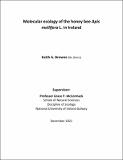Molecular ecology of the honey bee Apis mellifera L. in Ireland
Date
2021-12-10Author
Browne, Keith
Metadata
Show full item recordUsage
This item's downloads: 86 (view details)
Abstract
The honey bee sub-species native to Ireland is Apis mellifera mellifera, referred to locally as
the Black bee. It is the same sub-species that has undergone widespread extinction across the
rest of its native range in northern Europe as a consequence of habitat loss, replacement,
hybridisation, and colony death caused by the novel parasite Varroa destructor.
A programme to locate and selectively breed for bees resistant to V. destructor was initiated
and investigations were made into the genotypes of the monitored colonies. Using a
combination of mtDNA, microsatellite and SNP markers, the queen lineage and extent of
hybridisation between M and C lineages in a selection of bees was determined.
As a possible genetic source of resistance to the parasite, free-living, unmanaged colonies
were located using a citizen science approach. They were also genotyped using the same
markers and their survival was monitored.
Eight apiaries were sampled for bees, brood, and pollen to investigate pollen use by Irish
honey bees between apiaries and colonies located in similar rural landscapes and to make the
first concurrent study of the gut bacteria of these bees.
An extensive trial indicated that the process of creating a widespread breeding programme
may be prohibitively difficult to achieve in an Irish context. The reasons behind this are
discussed and a suggestion is made for a modular, localised model. The majority of bees
genotyped, whether managed or free-living, are revealed as M-lineage by mtDNA genotyping
and assigned as the sub-species native to Ireland. The citizen science approach resulted in the
discovery of a large free-living bee population living in natural and artificial cavities. The
survival of a number of these colonies was monitored for periods exceeding the three year
limit expected of colonies infested with V. destructor. The pollen data added to our knowledge
from the single previous peer-reviewed research on honey bee pollen in Ireland by revealing
the use of a significant number of new plant species. These new data permit a temporal
comparison between and within apiaries and are compared to a concurrent gut bacteria
profile.


